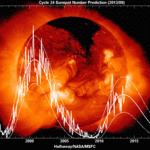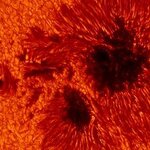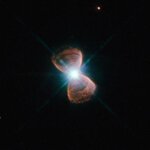Space

The solar system is crowded with small objects like asteroids and comets, and most have stable orbits which keep them out of harm’s way, but a small proportion of them are in orbits that risk collision with planets.
Smaller objects are more numerous and therefore result in more frequent collisions. The recent meteor seen over Chelyabinsk, Russia, in February 2013, was rare because the object was relatively large, around 17 meters across. However, the giant planet Jupiter is a much bigger target due to its tremendous gravitational attraction -- and it gets hit far more often than the Earth.…

Predicting the behavior of a sunspot cycle is fairly reliable once the cycle is well underway (about 3 years after the minimum in sunspot number occurs(1). Prior to that time the predictions are less reliable but planning for satellite orbits and space missions often require knowledge of solar activity levels years in advance.
A number of techniques are used to predict the amplitude of a cycle during the time near and before sunspot minimum. Relationships have been found between the size of the next cycle maximum and the length of the previous cycle, the level of activity at sunspot minimum…

6,000 light-years away, in the constellation of Scorpius, nebula IC 4628 is a huge region filled with gas and clumps of dark dust which produces brilliant hot young stars. In visible light, these stars appear as a blue-white color, but they also emit intense radiation in other parts of the spectrum — most notably in the ultraviolet.
The Prawn Nebula is around 250 light-years across, covering an area of sky equivalent to four times that of the full Moon. Despite this huge size it has been often overlooked by observers due to its faintness and because most of its light is emitted at wavelengths…

NASA's Voyager 1 spacecraft has been hurtling away from the Sun since it was launched in 1977 and various reports have indicated that the spacecraft has left the heliosphere, the bubble of hot, energetic charged particles surrounding the Solar System, and entered into a region of cold, dark space, known as interstellar space.
New measurements show that plasma densities around the spacecraft are consistent with theoretical predictions of the interstellar medium and that Voyager 1 arrived in this cold, unexplored interstellar region on or about 25 August, 2012.
The Voyager 1 spacecraft…

Astronomers have provided the best three-dimensional map yet of the central parts of the Milky Way. It shows that the inner regions take on a peanut-like appearance from some angles. This odd shape was mapped by using public data from ESO’s VISTA survey telescope along with measurements of the motions of hundreds of very faint stars in the central bulge.
One of the most important and massive parts of the galaxy is the galactic bulge. This huge central cloud of about 10 000 million stars spans thousands of light-years, but its structure and origin were not well understood.
Unfortunately, from…

Astronomers has begun to map the location of the most massive and mysterious objects in our galaxy – the Southern Milky Way and its giant gas clouds, where new stars are born.
Using the 22 meter Mopra millimetre wave telescope at Coonabarabran, the team identifies the galactic clouds of molecular gas - which can be up to 100 light years across from the carbon monoxide they contain.
Some of the options for how large giant molecular clouds form include the gravitational collapse of an ensemble of small clouds into a larger one, or the random collision of small clouds which then…

In the classic story "Mary Poppins", the lead character told the children she was caring for that she would stay until the wind changed.
Things are a little different in Britain. In many parts of the US, the wind changes every five minutes, but she meant that there was a season (and a reason) she would remain and the wind would be a harbinger that her job was done and she would move on.
We might like to think that on a cosmic scale, things are more predictable than the weather in Kentucky but, if they are, it is only slightly. Researchers benefiting from data gathered by 11 spacecraft…

The Sun is a magnetically active star. Its activity manifests itself as dark sunspots and bright faculae - granular structures that are slightly hotter or cooler than the surrounding photosphere - on its visible surface, as well as violent mass ejections and the acceleration of high-energy particles resulting from the release of magnetic energy in its outer atmosphere.
The frequency with which these phenomena occur varies in a somewhat irregular activity cycle of about 11 years, during which the global magnetic field of the Sun reverses. The solar magnetic field and the activity cycle…

Astronomers have explored more than 100 planetary nebulae in the central bulge of our galaxy and found that butterfly-shaped members of this cosmic family tend to be mysteriously aligned — a surprising result given their different histories and varied properties.
The final stages of life for a star like our Sun result in the star puffing its outer layers out into the surrounding space, forming objects known as planetary nebulae in a wide range of beautiful and striking shapes. One type of such nebulae, known as bipolar planetary nebulae, create ghostly hourglass or butterfly shapes around…

A long-standing mystery has been why most super massive black holes (SMBH) at the centers of galaxies have such a low accretion rate; they swallow very little of the cosmic gases available and instead act as if they are on a severe diet.
The signature X-ray emissions from super massive black holes, which come from an area much larger than the black holes themselves, are often so surprisingly faint that the objects are difficult to distinguish from their galaxy centers. There has been a big mystery about why most of these black hole signals are so faint.
Taking advantage of very long…